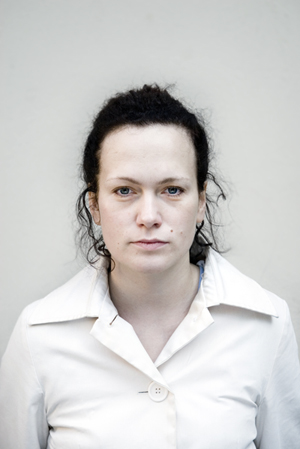
Ujazdów Castle is a castle in the historic Ujazdów district, between Ujazdów Park and the Royal Baths Park, in Warsaw, Poland.

Ursula von Rydingsvard is a sculptor who lives and works in Brooklyn, New York. She is best known for creating large-scale works influenced by nature, primarily using cedar and other forms of timber.

Alina Szapocznikow was a Polish artist and Holocaust survivor. Recognized as one of the most important Polish sculptors of the post-war era, Szapocznikow utilized diverse and experimental mediums to investigate and examine the human form, recalling genres such as surrealism, nouveau realism, and pop art.
Agnieszka Brzezanska is a Polish artist based in Warsaw. She uses paint and video to imply narrative and significance in ordinary objects.
Zuzanna Janin, is a Polish visual artist and former teenage actor. Janin lives and works in Warsaw and London. Janin has created sculpture, video, installation, photography and performatives. She used the names Zuzanna Baranowska (1990-1992) and from 1992 Zuzanna Janin. Her work was shown in the Museum of Contemporary Art, Chicago; and A.I.R Gallery New York. She is included in Feminist Artists Data in Brooklyn Museum, NY.
Koji Kamoji is a Japanese/Polish contemporary artist, who lives and works in Warsaw, Poland.
Tomasz Jerzy Vetulani is a Polish painter, drawer and sculptor. Born and educated in Kraków, he moved to Utrecht in 1991, and he has been active there since, holding also a citizenship of the Netherlands. In his works, using among others silicone and sponge, he includes both personal references and comments on current political and social issues.
Olga Lewicka is a visual artist. Polish born, she lives and works in Berlin. Her practice focuses on painting, but it also encompasses installation, collage, performance, text and artist book.

Jerzy Bereś was a Polish sculptor, author and performance artist.

Natalia Lach-Lachowicz was a Polish artist who worked with paint, photography, drawing, performance, and video art. Sean O'Hagan, writing in The Guardian in 2017, described her as "a neglected early-1970s Polish-born pioneer of feminist avant garde image making".
Szymon Roginski is a Polish photographer.

Anna Baumgart is a Polish artist, best known for her large installation pieces and film. She is based in Warsaw. While she covers many different issues in her works, "all of them share a preoccupation with repression." Her works are in the permanent collections of several Polish museums.

Magda Bielesz – painter, author of installations, objects, drawings, videos.

Joanna Zastróżna is a Polish photographer and filmmaker. She graduated in 1997 from the Academy of Fine Arts in Gdańsk. Zastróżna resides in Sopot and in Sidi Ifni.
Marek Kijewski and Małgorzata Malinowska, Polish artists, were cooperating since 1996 as Kijewski/Kocur duo in Warsaw, Poland. They often worked in the studios of the Centre of Polish Sculpture until the artist's death in 2007. Their works, in Polish art, was inspired by pop art and it showed the most distinct example of using pop art in the era of post-modernist experiments and reactions to the new reality and new economic-cultural situation that was forming in Poland in the early '90s.
Karolina Halatek is a Polish contemporary visual artist working in a field of installation art, using light as a key medium. Karolina Halatek creates experiential site-specific spaces that incorporate visual, architectural and sculptural elements. Seeing her work primarily as a catalyst for experience, Karolina creates installations that have strong experiential and immersive characteristics, often the result of collaborations with quantum physicists, founders of the superstring theory and precision mechanical engineers.

Małgorzata Turewicz Lafranchi is a visual artist. Born in Poland, since 1994 she has lived and worked in Bellinzona in the Ticino canton of Switzerland.
Tomasz Machciński was a Polish photographer, performer, and actor. He is known as the "man of a thousand faces". He lived and worked in Kalisz.
Polina Vladimirovna Kanis is a Russian artist, winner of the Kandinsky Prize (2011) and the Sergey Kuryokhin Prize (2016). She graduated from the Rodchenko Art School (Moscow) in 2011. Her work has been presented in numerous solo and group exhibitions, film festivals and film screenings, including a solo exhibition at the Haus der Kunst Munich (2017)., the VISIO program at Palazzo Strozzi in Florence (2019), the parallel program of the Manifesta 10, in 2015 at the Ural Industrial Biennale of Contemporary Art, Garage Museum of Contemporary Art, the VI Moscow International Biennale of Young Art (2015), the Moscow International Experimental Film Festival, the Hamburg Short Film Festival (2019) and many others. Her films are in the collections of numerous museums and foundations, including the Fonds régional d'art contemporain Bretagne, Fondazione In Between Art Film, Rome, Foundation Kadist, Paris, etc. Kanis was an artist-in-residence at the Rijksakademie van beeldende kunsten programs in Amsterdam (2017-2018) and ISCP New York (2020).

Ewa Ciepielewska is a Polish painter, performance artist and an activist.









